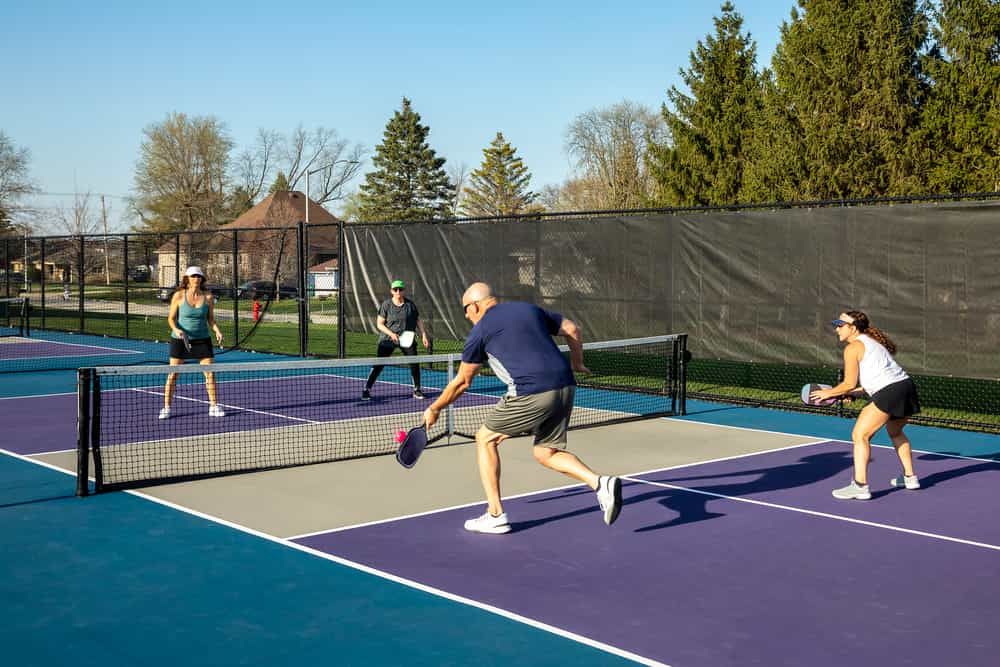The economics of Pickleball Court construction: a comprehensive guide
Key takeaways:
- Gaining insight into construction costs and considerations is vital for informed investment in a pickleball court.
- DIY efforts can offer savings, yet professional installations guarantee quality and often come with warranties.
- Material choices, court location, and added accessories can significantly influence the final cost of the court.
The recent explosion in popularity of pickleball has been impressive, not just as a pastime but as a community builder. This increasing interest has caused many to consider the construction of their outdoor courts. Before embarking on such a project, it’s crucial to address a fundamental question: how much does it cost to build a pickleball court outdoors? By understanding the economic factors in constructing a pickleball court, enthusiasts and community developers can plan efficiently, make informed financial choices, and bring value to their communities through this engaging sport. This guide will offer a detailed look into the costs and strategies that can help pave the way for a successful and budget-friendly pickleball court construction.
Introduction to Pickleball popularity
The game of pickleball has come a long way since its inception on Bainbridge Island in the 1960s. Its appeal reaches far beyond its simple and accessible gameplay; pickleball is a low-impact, high-fun activity that positively affects individuals’ physical and social well-being. Communities have taken note of this trend. According to The New York Times, the infrastructure supporting pickleball has seen rapid growth as the sport’s economic impact on small towns and large cities has become increasingly significant. This guide aims to inform interested parties of the costs involved in pickleball court construction and showcase the potential community and economic benefits of such an endeavour.

Understanding the basic requirements
Constructing a pickleball court isn’t more complex than painting lines on any flat surface. Specific dimensions are officially recommended for pickleball courts: a 20 by 44-foot rectangle for the playing area, with additional space around the perimeter to ensure players have room to move during play. This space can vary, but an extra margin of at least 10 feet on each end and 5 feet on the sides is typical. The choice of materials also matters as they must endure outdoor conditions and affect the speed and quality of play. Basic materials begin with surface coatings, concrete or asphalt for the court, galvanized steel for the nets, and appropriate paint for the lines.
Estimating the cost factors
When considering building a pickleball court, potential builders will face various costs. Items to consider include the cost of surfacing, which can vary depending on whether one selects asphalt, concrete, or a specialised outdoor tile. Labour costs present another significant consideration, especially for those weighing whether to undertake the project independently or hire professionals. A budget for a pickleball court must also account for the cost of accessories such as nets, lighting for night play, fencing to contain stray balls, and durable, weather-resistant seating for players awaiting their turn on the court.
Deciding Between DIY and professional installation
For those with some construction expertise and a willingness to get their hands dirty, a DIY pickleball court installation could be a rewarding and cost-saving project. Carefully executed, it could save thousands in labour fees. However, precision is crucial when marking out and installing a court. For those lacking the time or skills, a professional installation ensures the job’s done right the first time, safeguards against future issues, and may come with warranties or guarantees. Weigh these considerations carefully to decide which approach might be best for your situation.
Maximising your budget
Whether managing a municipal project or adding a court to your backyard, finding ways to stretch your dollar without sacrificing quality is critical. One way to approach pickleball court construction is through careful budget planning and procurement strategies. Consulting with multiple contractors and suppliers can provide a clear picture of the cost variance and opportunities for savings. Value engineering options, like phased builds or selecting alternative materials that meet standards for play but come at a lesser cost, help keep the project within budget. Furthermore, instituting a robust maintenance plan can significantly reduce long-term operational costs, preventing the need for extensive repairs or complete overhauls due to neglect.
Location and permitting challenges
Before breaking ground, it’s imperative to address zoning and legal considerations. Getting a pickleball court approved can be involved, often requiring permits and ensuring compliance with local building codes and community standards. According to National Public Radio (NPR), these factors can be pretty complex, and overlooking them could result in project delays or fines. Engaging with local authorities early in the planning stage to understand zoning restrictions, height regulations, and noise ordinances will pave a smoother path to a compliant and approved pickleball court.
Grading and site preparation
An adequately graded site affects not only the playability of a pickleball court but also its drainage and longevity. Incorrect grading can lead to water accumulation and early deterioration, raising long-term maintenance costs. Grading a site typically involves removing topsoil, levelling the ground, and possibly installing a sub-base layer to support the surface material. Though this can be a substantial part of the project’s expense, it is an investment in the court’s future playability and durability.

Surfacing options for optimal play
The choice of surfacing will significantly impact the cost and the final playing experience of a pickleball court. Concrete is known for its longevity and low maintenance, but it can be the most expensive option. Asphalt, while slightly less costly, may require more maintenance over time. More recent innovations like modular suspended tile systems offer quick installation and excellent drainage benefits but come at a higher initial cost. The differences in material price, installation time, and maintenance requirements should be thoroughly assessed to make a choice that aligns with your budget and expectations for the court.
Accessories and enhancements
Once the surface of a pickleball court is in place, the accessories bring the game to life. Essential items like durable, weatherproof nets and well-marked lines are must-haves, but other enhancements can range from practical to premium. Consider amenities like shaded seating areas and storage options for equipment. Furthermore, the addition of lighting can be a significant expense, but it is crucial if the court is used during evening hours. It’s essential to balance the desired features and what the budget will allow.
Making the most of your investment
A well-constructed pickleball court is more than just a venue for sport—it’s a community asset that can offer returns well beyond the initial investment. The value a pickleball court adds to a community space or a private property extends from the potential for hosting tournaments to improving property values. Offering lessons or organising social events for public facilities can help recoup construction costs and foster a vibrant community space. A pickleball court can be a unique selling point in private settings, increasing property appeal and potential resale value.
![[AD] We went to the newly opened Cha Sha Kingston a couple of weeks ago, and wow — taste bud adventure unlocked! The boys devoured the masala fries and chicken tikka rolls, while we couldn’t get enough of that epic kebab butter curry 😍🍛.
It’s amazing value for food this tasty (and everyone left happy and VERY full!).
Delicious food, vibrant vibes and incredible value — the perfect combo for your next meal.
📍Cha Sha Kingston
43 Surbiton Road, KT1 2HG
🌐 chasha.co.uk
Other Cha Sha locations in Birmingham, Ilford, Southampton and Wembkey
#ChaSha #ChaShaKingston #KingstonEats #FoodieFinds #UKFoodie #FoodReview #KingstonUponThames #FamilyEats #FamilyDining #FoodieKids](https://suburban-mum.com/wp-content/uploads/2016/02/574770541_18560351146016840_6855048070839528040_n-180x320.jpg)

![[AD] We’re a cricket-mad family, so we’re buzzing that @thehundred is back this August! 🏏🔥
To get ready, M tried out the official FREE Activity Pack — and it’s brilliant! 🙌
Packed with fun games, creative challenges and sporty tasks, it’s perfect for getting kids hyped whether you’re at home or on the go.
👉Download yours now (link in bio)
@londonspirit @ovalinvincibles #EveryMomentCounts #TheHundred
#EnglandCricket #CricketFamily #TheHundredCricket #LondonBloggers #Cricket #CricketIsLife #kidsfun](https://suburban-mum.com/wp-content/uploads/2022/11/505472555_18531279601016840_7092520074819907569_n-180x320.jpg)



![[AD - Press visit]
We enjoyed the glorious sunshine this weekend with a trip to Brighton. We went on the @brightoni360official which is right by the sea front.
The i360 pod take a slow journey up, allowing you to take in views across Brighton and the South Downs 450ft above ground. There’s a bar inside with drinks and snacks available to purchase and the experience lasts 25 minutes.
Afterwards, we headed to the open air roller rink for a roller skating session!
The roller rink is:
⭐ Suitable for over 5s
⭐ £6.50 if you have your own skates or £9.50 if you need to hire them
⭐ 45 minutes per session
Full details to visit the i360 + skating
📍 Brighton i360, Lower Kings Road, Brighton BN1 2LN
🚗 Parking nearby (we parked in the Regency Square Car park)
🎟️ Prices start from £25.40 for an adult and £16.90 for a child
🕐 Opening hours are currently Sun-Fri 10.30am-18.30pm and until 19.30pm on Saturdays
☕️ Bar inside the i360, cafe and gift shop
Book tickets here:
https://tickets.brightoni360.co.uk/tickets/?_ga=2.195305772.1869001490.1689671753-1757164059.1689671753/#events?eventid=157](https://suburban-mum.com/wp-content/uploads/2015/04/417980235_313576471048632_3682382982231216432_n.jpg)

![[AD] ***Summer of fun at Barracudas Activity Camps!****
There is plenty for kids to do at @barracudas_activity_day_camps
From Tennis, Archery, Swimming, Motor Sports and more you can be sure that there will be something for kids aged 4.5-14. ⚽🏈🥅🎾🏓🏎️🏹🏊♂️🏉
You can book on a day by day basis - so it can fit in with any other days out/activities you have planned and there are early drop off and late pickup options available. Barracudas are also Ofsted registered so you can use your Childcare Vouchers too.
⭐⭐⭐Get £20 off a week or £4 off a day using my discount code: MARIA20⭐⭐⭐
#BarracudasActivityDayCamp #BarracudasActivityCamp #BarracudaAmbassadors #SummerHolidays #SchoolHolidays #Summer2023 #SummerCamp #DayCare #Camp #KidsCamp #surreymummy #surreymums #SummerOfFun #ActivityCamps #HolidayCamps #Childcare #SchoolHolidays #schoolholidaycamps](https://suburban-mum.com/wp-content/uploads/2024/07/353583570_625625966167953_545896259645102575_n.jpg)



![[AD] We have some super exciting news...we have been chosen to be Laser Quest Ambassadors, and the boys are over the moon!
We are really lucky that our local Laser Quest (@laserquestkingston) is just around the corner from us. It means we can pop in of a weekend or anytime during the school holidays, and with summer just around the corner, I know Laser Quest will be one of our go-to places for some family fun.
As well as games of Laser Quest, there are also VR experiences and arcade amusements too. To find out a bit more about how Laser Quest works, you can read my blog post: https://www.suburban-mum.com/laser-quest-kingston/ (clickable link in bio)
Don't forget to keep an eye out for our Laser Quest posts - I'm going to be giving away two family passes to use at Laserquest Kingston!
If you can't wait and want to head down to Laser Quest to try it out, use the code SUMMER30 for 30% off your booking. The code is valid from now until the end of August 2023 and can be used on Laser Quest games and birthday party bookings.
#LaserquestAmbassador #Laserquest #LaserquestKingston #ActivitiesForKids #FamilyFun #DaysOutWithKids #Lasertag #LaserquestVR #Kingston #ThingsToDoInKingston #SurreyFamilyDaysOut #ThingsToDoWithKids #RainyDayFun #SurreyMummy #SurreyLife #LifeWithKids #LifeWithBoys #familyfunday](https://suburban-mum.com/wp-content/uploads/2015/04/353230107_797358078406942_2405522556733455165_n.jpg)

![[AD] The sun has finally made an appearance and the boys have been making the most of it by spending it
in the garden.
They’re go-to is always football and they’ve been trying to improve their aim and accuracy with the new Messi Foldable Footlball goal from the #MessiTrainingSystem range.
I love the fact the goal is foldable, making it easy to store away when not in use. It is also lightweight so you can effortlessly pack it up and take it to the park or to a friend’s house.
The Messi Foldable Football Goal retails at £36 and can be purchased from @argos
You can read my full review here: https://www.suburban-mum.com/messi-foldable-football-goal/
#TrainLikeMessi #FoldableFootballGoal #FootballSkills #OutdoorFun #LionelMessi #LeoMessi #FootballAtHome #OutdoorKids #JustGetOutside #OutdoorsAndFree #ScreenFreeKids #WhateverTheWeatherKids @flair_gp](https://suburban-mum.com/wp-content/uploads/2015/04/341194882_615024710178056_41977149395989448_n.jpg)

![[AD] We are absolutely thrilled to announce that we are Barracuda Ambassadors again this year.
With Easter just around the corner, the boys were sent the @barracudas_activity_day_camps new camp kit in preparation for the school holidays.
There’s a wide range of activities for kids aged 4.5 - 14 including Tennis, Archery, Basketball, Arts & Crafts and more.
If you like the sound of Barracudas, find out more over on their website. You can also save £20 a week or £4 a day, using my discount code: MARIA20](https://suburban-mum.com/wp-content/uploads/2024/07/336812306_765234558514317_685553691647241974_n.jpg)


![[AD - Gifted]
Last weekend we were invited to try out @tsarettaspice’s new Bottomless Brunch menu and I can tell you it was thumbs up all round!
There’s a good choice tapas on offer from Punjabi fish fingers, Indo Chinese Chicken to Spiced Lamb Scotch Eggs and Manchurian Cauliflower (which was amazing!)
If you’re local to Twickenham and fancy giving them a try here’s are the details.
Tsaretta Spice Bottomless Brunch
⭐️£37.50 per head for bottomless Prosecco or cocktail of the day
⭐️£55 per head for bottomless Champagne
⭐️ Food included: 4 tapas selections and dessert or 2 tapas selections, a pav or naanwich and dessert
⭐️ Non-alcohol brunch is also available
Tsaretta Spice
55 Church Street
Twickenham
TW1 3NR
You can also read our full review over on the blog (link in bio)](https://suburban-mum.com/wp-content/uploads/2024/07/334565436_5960402314015030_663031098700829518_n.jpg)



